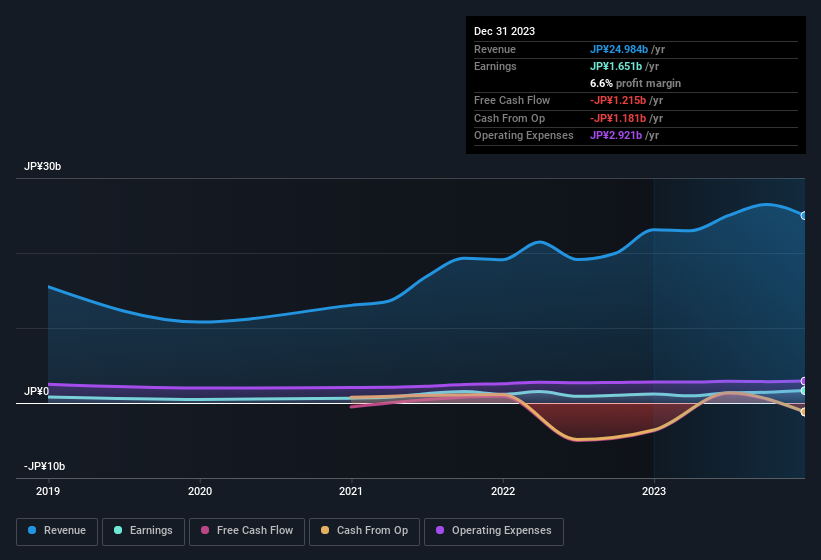J.E.T. Co., Ltd.'s (TSE:6228) stock was strong after they recently reported robust earnings. However, our analysis suggests that shareholders may be missing some factors that indicate the earnings result was not as good as it looked.
See our latest analysis for J.E.T

A Closer Look At J.E.T's Earnings
Many investors haven't heard of the accrual ratio from cashflow, but it is actually a useful measure of how well a company's profit is backed up by free cash flow (FCF) during a given period. In plain english, this ratio subtracts FCF from net profit, and divides that number by the company's average operating assets over that period. This ratio tells us how much of a company's profit is not backed by free cashflow.
Therefore, it's actually considered a good thing when a company has a negative accrual ratio, but a bad thing if its accrual ratio is positive. While it's not a problem to have a positive accrual ratio, indicating a certain level of non-cash profits, a high accrual ratio is arguably a bad thing, because it indicates paper profits are not matched by cash flow. That's because some academic studies have suggested that high accruals ratios tend to lead to lower profit or less profit growth.
J.E.T has an accrual ratio of 0.20 for the year to December 2023. Unfortunately, that means its free cash flow fell significantly short of its reported profits. Over the last year it actually had negative free cash flow of JP¥1.2b, in contrast to the aforementioned profit of JP¥1.65b. We also note that J.E.T's free cash flow was actually negative last year as well, so we could understand if shareholders were bothered by its outflow of JP¥1.2b. Unfortunately for shareholders, the company has also been issuing new shares, diluting their share of future earnings.
Note: we always recommend investors check balance sheet strength. Click here to be taken to our balance sheet analysis of J.E.T.
In order to understand the potential for per share returns, it is essential to consider how much a company is diluting shareholders. As it happens, J.E.T issued 16% more new shares over the last year. That means its earnings are split among a greater number of shares. To celebrate net income while ignoring dilution is like rejoicing because you have a single slice of a larger pizza, but ignoring the fact that the pizza is now cut into many more slices. Check out J.E.T's historical EPS growth by clicking on this link.
A Look At The Impact Of J.E.T's Dilution On Its Earnings Per Share (EPS)
As you can see above, J.E.T has been growing its net income over the last few years, with an annualized gain of 160% over three years. And the 38% profit boost in the last year certainly seems impressive at first glance. But in comparison, EPS only increased by 296% over the same period. So you can see that the dilution has had a bit of an impact on shareholders.
In the long term, earnings per share growth should beget share price growth. So it will certainly be a positive for shareholders if J.E.T can grow EPS persistently. But on the other hand, we'd be far less excited to learn profit (but not EPS) was improving. For the ordinary retail shareholder, EPS is a great measure to check your hypothetical "share" of the company's profit.
Our Take On J.E.T's Profit Performance
As it turns out, J.E.T couldn't match its profit with cashflow and its dilution means that earnings per share growth is lagging net income growth. Considering all this we'd argue J.E.T's profits probably give an overly generous impression of its sustainable level of profitability. Keep in mind, when it comes to analysing a stock it's worth noting the risks involved. To help with this, we've discovered 3 warning signs (2 are a bit concerning!) that you ought to be aware of before buying any shares in J.E.T.
In this article we've looked at a number of factors that can impair the utility of profit numbers, and we've come away cautious. But there are plenty of other ways to inform your opinion of a company. For example, many people consider a high return on equity as an indication of favorable business economics, while others like to 'follow the money' and search out stocks that insiders are buying. While it might take a little research on your behalf, you may find this free collection of companies boasting high return on equity, or this list of stocks that insiders are buying to be useful.
New: Manage All Your Stock Portfolios in One Place
We've created the ultimate portfolio companion for stock investors, and it's free.
• Connect an unlimited number of Portfolios and see your total in one currency
• Be alerted to new Warning Signs or Risks via email or mobile
• Track the Fair Value of your stocks
Have feedback on this article? Concerned about the content? Get in touch with us directly. Alternatively, email editorial-team (at) simplywallst.com.
This article by Simply Wall St is general in nature. We provide commentary based on historical data and analyst forecasts only using an unbiased methodology and our articles are not intended to be financial advice. It does not constitute a recommendation to buy or sell any stock, and does not take account of your objectives, or your financial situation. We aim to bring you long-term focused analysis driven by fundamental data. Note that our analysis may not factor in the latest price-sensitive company announcements or qualitative material. Simply Wall St has no position in any stocks mentioned.
About TSE:6228
J.E.T
Engages in the design, development, manufacture, sale, and after-sales maintenance service of semiconductor cleaning equipment in Japan, South Korea, China, Taiwan, and internationally.
Excellent balance sheet and good value.
Market Insights
Community Narratives





